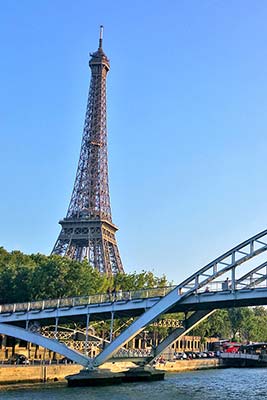
Paris is magnificent, but it’s also super-sized, crowded, and fast-paced. Take a deep breath, then use this orientation to the City of Light to help illuminate your trip. You’ll tap into Paris’ best sources for current events. Most importantly, you’ll learn to navigate Paris by Métro, bus, taxi, bicycle, or on foot. With the proper approach and a measure of patience, you’ll fall head over heels for Europe’s cultural capital. As Paris is the host of the summer 2024 Olympic Games, expect some changes from what’s described in this book before, during, and even after the games.
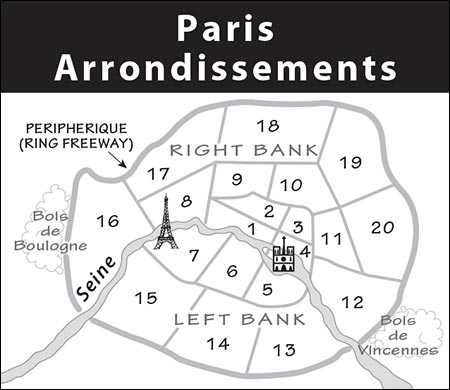
Paris is made up of 20 arrondissements (administrative districts) that spiral out from the center like an escargot shell. If your hotel’s zip code is 75007, you know (from the last two digits) that it’s in the 7th arrondissement. The city is peppered with Métro stops, and most Parisians locate addresses by the closest stop. So, in Parisian jargon, the Eiffel Tower is on la Rive Gauche (the Left Bank) in the 7ème (7th arrondissement), zip code 75007, Mo: Trocadéro (the nearest Métro stop).
As you’re tracking down addresses, these words and pronunciations will help: arrondissement (ah-rohn-dees-mahn), Métro (may-troh), place (plahs; square), rue (rew; road), avenue (ah-vuh-new), boulevard (bool-var), pont (pohn; bridge), and carrefour (kah-ruh-foor; intersection).
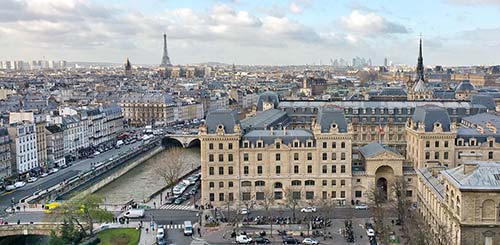
Paris’ tourist offices (abbreviated as “TI” in this book, www.parisinfo.com) can provide useful information. For a small fee, they sell individual tickets to sights and likely also Museum Passes (until the passes become digital only); however, they may have longer lines than the museums. TIs also sell tickets to local concerts and events.
The main TI is located at the Hôtel de Ville (daily 10:00-18:00, 29 Rue de Rivoli, on the north side of the building). You’ll find smaller TIs at Gare du Nord (Mon-Sat 8:00-18:00, closed Sun) and at the Puces St. Ouen flea market (Fri-Mon 9:45-13:00 & 14:00-18:00, closed Tue-Thu, 124 Rue des Rosiers). Both airports have handy TIs with long hours.
Event Listings: The weekly L’Officiel des Spectacles (available online at www.offi.fr or at any newsstand) has easy-to-decipher listings of the most up-to-date museum hours, art exhibits, concerts, festivals, plays, movies, and nightclubs (for tips on deciphering the listings, see here). The Paris Voice, with snappy English-language reviews of concerts, plays, and current events, is available online-only (www.parisvoice.com).
For a comprehensive rundown of the city’s train stations, airports, and options for parking, see the Paris Connections chapter.
Theft Alert: Paris is safe in terms of violent crime but is filled with thieves and scammers who target tourists. Some are aggressive—particularly with phone theft. Keep your phone out of sight on Métro rides and in crowded places. Wherever there are crowds (especially of tourists) there are thieves at work. They thrive near famous monuments and on Métro and train lines that serve airports and high-profile tourist sights. Pickpockets work busy lines (e.g., at ticket windows at train stations). Look out for groups of young people who swarm around you (be forceful and walk away).
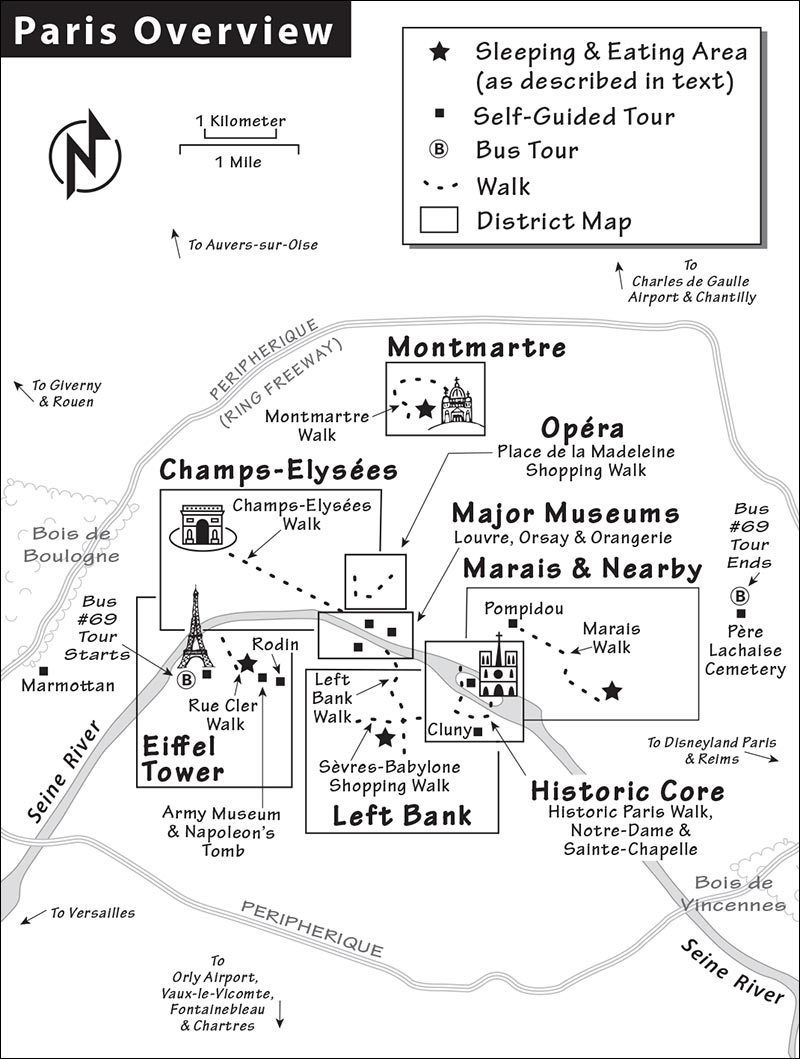
It’s also smart to wear a money belt. Put your wallet in your front pocket, loop your day bag over your shoulders, and keep a tight hold on your purse or shopping bag.
Muggings are rare, but they occur. If you’re out late, avoid dark riverfront embankments and any place with dim lighting and few pedestrians.
Paris has taken action to combat crime by stationing police at monuments, on streets, and on the Métro, and installing security cameras at key sights.
Tourist Scams: Be aware of the latest tricks, such as the “found ring” scam (a con artist pretends to find a “pure gold” ring on the ground and offers to sell it to you) or the “friendship bracelet” scam (a vendor asks you to help with a demo, makes a bracelet on your arm that seems like it can’t easily be removed, and then asks you to pay for it). Don’t be intimidated. They are removed with the pull of a string.
Distractions by a stranger can be a smokescreen for theft. As you try to wriggle away from the pushy stranger, an accomplice picks your pocket. Be wary of a “salesman” monopolizing your attention, an “activist” asking you to sign a petition (and then bullying you into a contribution), someone posing as a deaf person to show you a small note to read, or a sidewalk hawker inviting you to play shell games (their accomplices are likely lurking nearby). Also be skeptical of overly friendly people inviting you into bars late at night.
At airports and train stations, be wary of strangers offering help with ticket kiosks (look for a uniformed employee) or offering a ride. They may tell stories of problems with public transit—don’t fall for it. And those six-passenger tuk-tuks you see lined up below the Eiffel Tower and elsewhere are famous for overcharging tourists.
To all these scammers, simply say “no” firmly and step away purposefully. For reports from my readers on the latest scams, go to https://community.ricksteves.com/travel-forum/tourist-scams.
Pedestrian Safety: Busy Parisian sidewalks are like freeways, so act as if you were a foot-fueled car: Stick to your lane, look to the left before passing a slow-moving pedestrian, and if you need to stop, look for a safe place to pull over.
When crossing the street, look both ways and be careful of seemingly quiet bus/taxi/bike lanes. Parisian drivers are notorious for ignoring pedestrians. Don’t assume you have the right of way, even in a crosswalk. Keep your pace constant and don’t stop suddenly. By law, drivers are allowed to miss pedestrians by up to just one meter—a little more than three feet (1.5 meters in the countryside). Drivers calculate your speed so they won’t hit you, provided you don’t alter your route or pace. Speed limits are 30 kilometers per hour in the city center (about 19 miles per hour).
Be mindful of cyclists as you cross, too. Cyclists ride in specially marked bike lanes on wide sidewalks and can also use lanes reserved for buses and taxis. Bikes commonly go against traffic, so always look both ways, even on one-way streets.
Medical Help: There are many English-speaking resources for medical help in Paris, including doctors who will visit your hotel. For a list, see the Practicalities chapter.
Smart Sightseeing: Key Paris sights sell tickets in advance online, saving you time by not having to wait in ticket-buying lines (though you still will have to wait in a sometimes very slow security line). At some sights, you are required to book ahead, including the Louvre, Sainte-Chapelle, and Versailles; for others, like the Orangerie and the Catacombs, it’s not required, but should be, as it’s about the only way to get in during busy months. A Paris Museum Pass can help you skip the line at some sights (and can be purchased in advance). That pass, while very useful for many sights, is proving less helpful for the Louvre Museum, which limits the number of pass-holder entries each day (if pass-holder times are not available, you may have better luck buying individual tickets on the Louvre’s website). For more on these options, see “Sightseeing Strategies” in the Sights in Paris chapter.
Bookstores: Paris has several English-language bookstores. My favorites include Shakespeare and Company (some used travel books, daily 10:00-22:00, 37 Rue de la Bûcherie, across the river from Notre-Dame, see map on here, Mo: St-Michel, +33 1 43 25 40 93); Smith&Son (Mon-Sat 9:00-19:00, Sun 12:30-19:00, near the Tuileries at 248 Rue de Rivoli, see map on here, Mo: Concorde, +33 1 44 77 88 99); Abbey Bookshop (Mon-Sat 10:00-19:00, closed Sun, near the Cluny at 29 Rue de la Parcheminerie—see map on here, Mo: Cluny La Sorbonne, +33 1 46 33 16 24); San Francisco Book Company (used books only, Thu-Tue 10:00-20:00, closed Wed, north of Luxembourg Garden at 17 Rue Monsieur le Prince—see map on here, Mo: Odéon, +33 1 43 29 15 70); and Red Wheelbarrow (good selection for adults with a children’s shop next door, Mon-Sat 10:00-19:00, Sun 12:00-18:00, near the Luxembourg Garden at 11 Rue de Médicis—see map on here, +33 1 42 01 81 47).
Baggage Storage: Lockers and baggage check are available at some train stations (see the Paris Connections chapter) and several City Locker locations in central Paris (daily 8:00-22:00, book ahead, details at www.citylocker.paris).
Public WCs: Some public toilets are free but you get what you pay for. If it’s a pay toilet, the price will be clearly indicated, and the facility should be clean (thank the person who cleans). If there’s an attendant, it’s polite and sometimes required to leave a tip of €0.20-0.50. Booth-like toilets along the sidewalks provide both relief and a memory (don’t leave small children inside unattended). Restrooms in museums are free and the best you’ll find outside of your hotel. Bold travelers can walk into any sidewalk café like they own the place and find the WC. Or do as the locals do—order a shot of espresso (un café) while standing at the café bar (then use the WC with a clear conscience). Keep toilet paper or tissues with you, as some WCs are poorly stocked.
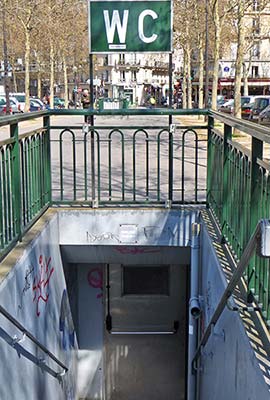
Tobacco Stands (Tabacs): These little kiosks—often just a counter inside a café—are handy and very local. Many sell public-transit passes, postage stamps (though not all sell international postage), and...oh yeah, cigarettes. (For more on this slice of Parisian life, see here.) To find a kiosk, just look for a Tabac sign and the red cylinder-shaped symbol above certain cafés.
Paris is easy to navigate. Your choices are Métro (in-city subway), regional train (commonly called RER—rapid transit tied into the Métro system), longer-distance suburban trains called Transilien, public bus, and taxi or Uber. Several tram (light rail) lines run at street level, accepting the same passes as the bus and Métro, but most travelers will find little use for them. Also consider the hop-on, hop-off bus and boat tours (described under “Tours in Paris,” later).
Public Transit Information: The Métro, RER trains, and public bus systems, all administered by RATP, share one helpful website: www.ratp.fr [URL inactive]. The free RATP app (Bonjour RATP) has a real-time journey planner, lets you buy and top up tickets and passes, can help you locate the best Métro station exit, and can tell you when the next bus will arrive (in English).
The following ticket options cover transit on the Métro, public buses, and RER trains. Paper tickets have been phased out and replaced with plastic Navigo travel cards and passes. Transit users will need to choose one of these two good options (the Navigo Découverte weekly pass is a particularly good value):
Navigo Easy Card: This reloadable card is the easiest option for most tourists. You can add funds to your Navigo Easy card and pay as you ride (one-time €2 fee, €1.90/ride, less for children under 10), or load the card with a 10-ride pass or day pass.
If your rides will be limited to central Paris (Zones 1-2), the 10-ride pass (“Navigo avec un carnet”) is a good deal at €16.90. Frequent riders may want to consider a day pass (Navigo Jour), which expires at midnight and costs €8.50 for Zones 1-2. To reach destinations outside Zones 1-2, you can add zones to your day pass (€14 for Zones 1-4, covers regional destinations like Versailles; €20.10 for Zones 1-5, covers airports and farther-flung destinations like Fontainebleau and Vaux-le-Vicomte).
A Navigo Easy card can be shared between travelers, but not for the same journey (in other words, you can’t hand the card to your travel partner across the turnstile). No photo is required, but make sure your card is loaded with enough euros to cover multiple fares. The Easy card is good for 1.5 hours (though not round-trips) on buses and the Métro, but you can’t transfer from one to the other on the same fare (it’ll take two fares).
To use your Navigo Easy card at the Métro turnstile, touch the card to the purple pad, wait for the green validation light and the “ding,” and you’re on your way.
Navigo Découverte Pass: This chip-embedded pass comes in weekly or monthly versions. The weekly version is a good value and generally pays for itself after four days of typical sightseeing. It costs about €30 and covers all forms of transit from Monday to Sunday (expires on Sunday at midnight, even if you buy it on, say, a Thursday). It’s good for all zones in the Paris region, which means that you can travel anywhere within the city center, out to the châteaux of Versailles, Vaux-le-Vicomte, and Fontainebleau, to Disneyland Paris, to Auvers-sur-Oise, and to Charles de Gaulle and Orly airports (except on Orlyval trains). This is a sensational value if you’re making regional trips. The card requires a one-time €5 fee to purchase and a color photo (can be taken for €5 at photo booths in major Métro stations; otherwise bring a postage stamp-sized photo of yourself, such as a passport photo; any photo works, even a selfie).
Buying and Loading a Navigo Card/Pass: You can buy your Navigo Easy card or Découverte pass at any staffed Métro station and at many tabacs (for locations, see the RATP website). The Bonjour RATP app lets you top up your Navigo Easy card, but it’s just as easy to use the machines inside Métro stations. Smaller Métro stations may not have staff on hand to sell new cards (find a nearby tabac), but all stations have machines to reload a Navigo Easy card. Some machines accept only credit cards and coins, though key stations have machines that take small bills of €20 or less (some American cards are accepted—try). These machines work logically, with easy-to-follow instructions in English.
RER stations linking Paris and many regional destinations (including airports) sell the Découverte pass.
Contactless Tickets and Passes: As an alternative to a physical ticket or Navigo card, you can buy a digital version on the Bonjour RATP app and store it on your phone. Hold your phone over the card reader to enter the Métro or board a bus. For details see www.ratp.fr [URL inactive].
Other Transit Passes: Skip the poor-value Paris Visite passes. If you are under 26 and in Paris on a Saturday or Sunday, you can buy an unlimited daily transit pass called Forfait Navigo Jeunes Week-end for the unbeatable price of €5.
In Paris, you’re never more than a 10-minute walk from a Métro station. Europe’s best subway system allows you to hop from sight to sight quickly and cheaply (runs 5:30-1:00 in the morning, Fri-Sat until 2:00 in the morning). Learn to use it. Begin by studying the color Métro map at the back of this book.
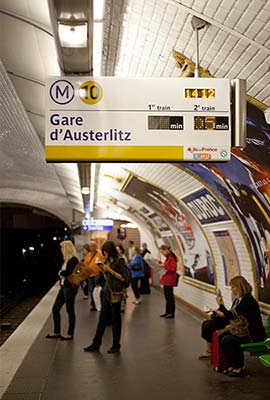
Using the Métro System: To get to your destination, determine the closest “Mo” stop and which line or lines will get you there. Lines are color-coded and numbered. You can tell their direction by the end-of-the-line stops. For example, the La Défense/Château de Vincennes line, also known as line 1 (yellow), runs between La Défense on its west end and Vincennes on its east end. Once in the Métro station, you’ll see the color-coded line numbers and/or blue-and-white signs directing you to the train going in your direction (e.g., direction: La Défense). Scan your Navigo card at the turnstile. Fare inspectors regularly check for cheaters, accept absolutely no excuses, and have portable credit card machines to fine you €60 on the spot.
Be prepared to walk significant distances within Métro stations (especially when you transfer). Transfers are free and can be made wherever lines cross, provided you do so within 1.5 hours and don’t exit the station. When you transfer, follow the appropriately colored line number and end-of-the-line stop to find your next train, or look for Correspondance (Connection) signs that lead to your next line.
When you reach your destination, blue-and-white Sortie signs point you to the exit. Before leaving the station, check the helpful Plan du quartier (map of the neighborhood) to get your bearings. At stops with several sorties, save time by choosing the best exit.
Métro Resources: Métro maps are in this book, free at Métro stations, online at www.ratp.fr [URL inactive], and included on freebie Paris maps at your hotel.
Beware of Pickpockets: Thieves dig public transit. You’ll hear regular announcements in the Métro to beware of les pickpockets (mobile phones are the most popular target). Keep nothing of value in your pockets, tuck your phone out of sight, and take care when buying tickets (watch your back). Be especially aware as you pass through the turnstile—if your pocket is picked, you end up stuck on the wrong side while the thief gets away. Stand away from Métro doors to avoid being a target for a theft-and-run just before the doors close. Any jostling or commotion—especially when boarding or leaving trains—is likely the sign of a thief or a team of thieves in action. Make any fare inspector show proof of identity (ask locals for help if you’re not certain). Keep your bag close and never show anyone your wallet.
Several street-level light rail lines serve parts of Paris but are generally not useful for tourists. They accept the same passes as the Métro and buses.
RER regional trains are an arm of the Métro, serving outlying destinations such as Versailles, Disneyland Paris, and Paris airports. These routes are indicated by thick lines on your subway map and identified by the letters A-K (see pronunciations in the “Transit Basics” sidebar). Throughout this book, I refer to this train system as “RER.”
Within the city center, the RER works like the Métro; it can even be speedier if it serves your destination directly, because it makes fewer stops. Unlike the Métro, not every RER train stops at every station along the way; check the sign or screen over the platform to see if your destination is listed as a stop (“toutes les gares” means it makes all stops along the way) or confirm with a fellow passenger before you board.
Métro passes are good on the RER; you can transfer between the Métro and RER systems with the same Navigo card or pass. But to travel outside the city (to Versailles or the airport, for example), you’ll need to have a Navigo Découverte pass or Easy card Navigo Jour day pass (zones 1-5), or buy a separate ticket. The Navigo Découverte covers all area train trips, including to the airport and Versailles.
These commuter trains, part of the national rail service SNCF, run from major train stations (Nord, Est, Lyon, Austerlitz, Montparnasse, and St. Lazare) and serve longer distance, suburban destinations like Versailles, Fontainebleau, and Vaux-le-Vicomte with faster service than via RER. Any Navigo card or pass that covers five zones will work for these destinations. For more on Transilien, see www.transilien.com.
Paris’ excellent bus system is worth figuring out. Buses require less walking and fewer stairways than the Métro, and you can see Paris unfold as you travel. Sure, they don’t seem as slick as the famous Métro and are subject to traffic jams—but savvy travelers know that buses can have you swinging through the city like Tarzan in an urban jungle. Most buses are now electric-only.
Bus Stops: Stops are everywhere, and most come with a good city bus map, route maps for each bus that stops there, a frequency chart and schedule, live displays showing the time the next bus will arrive, a plan du quartier map of the immediate neighborhood, and a soirées map explaining night service, if available (there are even phone chargers at some locations). Bus-system maps are also available in most Métro stations (and in the Paris Pratique booklet sold at newsstands). For longer stays, consider buying the Paris Urbain book of transit info, including bus routes.
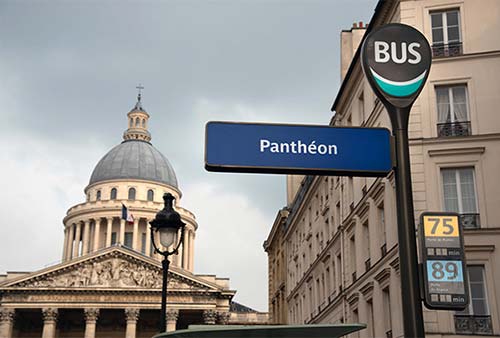
Using the Bus System: Buses use the same Navigo cards and passes as the Métro and RER. Buy your Navigo Easy card before boarding the bus (available at staffed Métro stations and many tabacs). Note that it may no longer be possible to buy single-ride tickets from the driver.
When a bus approaches, wave to the driver to indicate that you want to be picked up. Board through the front door. (Families with strollers can use any doors—the ones in the center of the bus are wider. To open the middle or back doors on long buses, push the green button located by those doors.) Scan your Navigo card on the purple touchpad, then keep track of which stop is coming up next by following the onboard stop display and route diagrams or listening to recorded announcements. When you’re ready to get off, push the red button to signal you want a stop, then exit through the central or rear door. Even if you’re not certain you’ve figured out the system, do some joyriding. I always check the bus stop near my hotel to see if it’s convenient to my sightseeing plans.
More Bus Tips: Avoid rush hour (Mon-Fri 8:00-9:30 & 17:30-19:30), when buses are jammed and traffic doesn’t move. While the Métro shuts down at about 1:00 in the morning (even later Fri-Sat), some buses continue much later (called Noctilien lines, www.ratp.fr/en [URL inactive]—select “Visiting Paris” from the drop-down menu, then “Getting Around at Night”). Navigo Easy card holders can transfer from one bus to another on the same fare (within 1.5 hours). However, you can’t do a round-trip or hop on and off on the same line using the same fare. You can use the same fare to transfer between buses and trams, but you can’t transfer between the bus and Métro/RER regional train systems (it’ll take two fares). Before you board the bus, check the screen on the front: If the line number appears with a slash, it means the bus does not go to the end of line (called service partiel).
Uber works in Paris like it does at home. Prices are roughly the same as taxis (and sometimes more), but you can generally get an Uber wherever you are within five minutes, you don’t have to track down a taxi stand, and you can message the driver if you don’t see the car (most speak some English). Uber is less appealing during rush hour, when taxis can use taxi/bus lanes while Uber drivers sit in traffic, and for transfers from Paris’ airports to the city center (taxis have flat rates and designated pick-up areas; Uber uses dynamic pricing and you’ll need to arrange a pick-up point).
Parisian taxis are reasonable, especially for couples and families. The meters are tamper-proof. Fares and supplements (described in English on the rear windows) are straightforward and tightly regulated. Cabbies are legally required to accept four passengers, though they don’t always like it. If you have five in your group, you can book a larger taxi in advance (your hotelier can call), or try your luck at a taxi stand. A surcharge may be applied for a fifth rider. For tips on getting to and from Paris’ airports by taxi, see the Paris Connections chapter.
Rates: The meter starts at €2.60 with a minimum charge of €7.30. A typical 20-minute ride (such as Bastille to the Eiffel Tower) costs about €25 (versus about €2/person on the Métro or bus). While drivers should accept credit cards, they prefer cash, and some will claim that their credit card machine isn’t working in order to be paid in cash. Taxi drivers charge higher rates at rush hour, at night, and all day Sunday. To tip, round up to the next euro (at least €0.50). The A, B, or C lights on a taxi’s rooftop sign correspond to hourly rates, which vary with the time of day and day of the week (for example, the A rate of about €36/hour applies Mon-Sat 10:00-17:00). Tired travelers need not bother with the subtle differences in fares—if you need a cab, take it.
How to Catch un Taxi: You can try waving down a taxi, but it’s often easier to ask someone for the nearest taxi stand (“Où est une station de taxi?”; oo ay ewn stah-see-ohn duh tahk-see). Taxi stands are indicated by a circled “T” on good city maps and on many maps in this book. To order a taxi in English, call the reservation line for the G7 cab company (+33 1 41 27 66 99), or ask your hotelier or server to call for you. When you summon a taxi by phone, a set fee of €4 is applied for an immediate booking or €7 for reserving in advance (this fee will appear on the meter when they pick you up). You can also book a taxi using the cab company’s app, which provides approximate wait times (surcharge similar to booking by phone). To download an app, search for either “Taxi G7” or “Taxis Bleus” (the two major companies, both available in English; when entering your mobile number, use “+1” before the area code for a US/Canadian phone number).
Taxis are tough to find during rush hour, during Métro strikes, when it’s raining, on weekend nights, or at night after the Métro closes. If you need to catch an early morning train or flight, book a taxi the day before (especially for weekday departures; your hotelier can help).
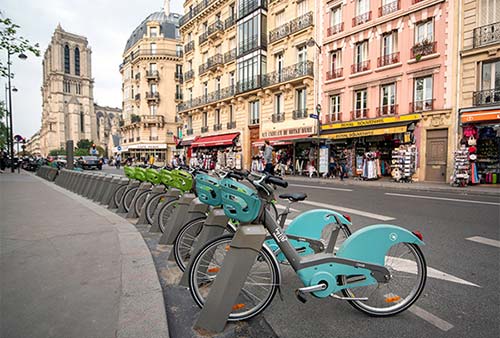
Paris is surprisingly easy by bicycle. The city is flat, and riders have access to more than 370 miles of bike lanes and many of the priority lanes for buses and taxis (be careful on these). You can rent from a bike-rental shop or use the city-operated Vélib’ bikes (best for short rides—explained later).
Though I wouldn’t use bikes to get around routinely (traffic is a bit too intense), they’re perfect for a joyride away from busy streets, especially on the riverside promenades. Bike-rental shops also have good route suggestions. For information on bike tours—a safe way to sightsee with a group—see “Tours in Paris,” later.
Urban bikers will find Paris a breeze. First-timers will get the hang of it quickly enough by following some simple rules. Always stay to the right in your lane, bike single-file, stay off sidewalks, watch out for opening doors on parked cars, signal with your arm before making turns, and use bike paths when available. Obey the traffic laws as if you were driving a car, with two exceptions: When passing vehicles or other bikes, always pass on the left (it’s illegal to pass on the right); and where there is no stoplight, always yield to traffic merging from the right, even if you’re on a major road and the merging driver is on a side street. Use the bell on your bike to warn pedestrians who don’t see you.
Sundays are peaceful for pedaling, when the city’s “Paris Respire” program opens up some streets to cyclists and rollerbladers (cars are banned) from 9:00 to 18:00. Participating neighborhoods include the Marais, Montmartre, the Champs-Elysées, the Rue Mouffetard area east of Luxembourg Garden, and the Rue Daguerre area (near the Denfert-Rochereau Métro station). Also open exclusively to nonmotorized traffic (and described on here) are roads along the Seine’s left and right banks. Neighborhood bike-path maps are available at www.paris.fr/parisrespire. The TIs have a helpful “Paris à Vélo” map, which shows all dedicated bike paths. Many other versions are available for sale at newsstand kiosks, some bookstores, and department stores.
Rental Bikes: The following companies rent bikes to individuals and offer general tips about cycling in Paris.
Bike About Tours is your best bet for bike rental, with good information and kid-friendly solutions such as baby seats, tandem attachments, and kid-sized bikes. Their office/café, Le Peloton, offers bikes, tours, and artisan coffee (daily 9:30-17:30, shop/café near Hôtel de Ville at 17 Rue du Pont Louis Philippe—see map on here, Mo: St-Paul, +33 6 18 80 84 92, www.bikeabouttours.com).
Fat Tire Tours has a limited supply of bikes for rent, so call ahead to check availability (RS%—€2/day rental discount with this book, 2-discount maximum; daily 9:00-18:30, bike rental only after 11:00 as priority is given to those taking a tour, near the Eiffel Tower at 24 Rue Edgar Faure—see map on here, Mo: Dupleix or La Motte-Picquet-Grenelle, +33 1 82 88 80 96, www.fattiretours.com/paris).
Vélib’ Bikes: The city’s Vélib’ program (from vélo + libre = “bike freedom”) scatters thousands of bikes at racks across town for use by locals and tourists alike (see sidebar). This is a great option for one-way trips or rentals of a few hours or less; pricing is structured to discourage longer use. For longer rentals, try one of the companies I list earlier.
Lime Bikes: You can rent bikes with the easy-to-use Lime Bike app.
 To sightsee on your own, download my free audio tours that illuminate some of Paris’ top sights and neighborhoods, including the Historic Paris and Rue Cler walks, and tours of the Louvre Museum, Orsay Museum, Père Lachaise Cemetery, and Versailles Palace (for details, see the sidebar on here). Some tour companies offer a discount when you show this book (indicated in these listings with the abbreviation “RS%”).
To sightsee on your own, download my free audio tours that illuminate some of Paris’ top sights and neighborhoods, including the Historic Paris and Rue Cler walks, and tours of the Louvre Museum, Orsay Museum, Père Lachaise Cemetery, and Versailles Palace (for details, see the sidebar on here). Some tour companies offer a discount when you show this book (indicated in these listings with the abbreviation “RS%”).
Paris has a variety of bus tours, but the cheapest way to see the city by bus is simply to hop on city bus #69 and follow my Bus #69 Sightseeing Tour (see that chapter).
Several companies offer double-decker bus services connecting Paris’ main sights, giving you an easy once-over of the city with a basic recorded commentary. Buses normally run from about 9:30-19:00 in high season. You can hop off at any stop, tour a sight, then hop on a later bus. It’s dang scenic—if you get a top-deck seat and the weather’s decent. But because of traffic and stops, these buses are sloooow. (Busy sightseers will do better using the Métro.) On the plus side, because the buses move so slowly, you have time to read my sight descriptions, making this a decent orientation tour—and there’s free Wi-Fi on board. Buy tickets from the driver or online.
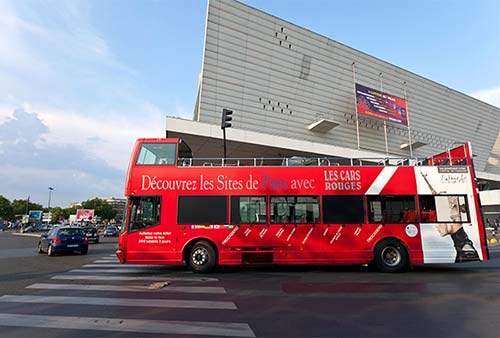
TootBus has several ticket options with reasonably frequent service on a well-designed, 10-stop route covering central Paris. You can catch the bus at just about any major sight (look for the TootBus icon on public transit bus shelters and signs). Tickets are valid only for the days you purchase them, so get started early (€35-€44 for 1-3 days, €29 for 2-hour “express tour,” www.tootbus.com).
Big Bus Paris runs a fleet of buses around Paris with recorded narration—or use their better free app for sight descriptions (€38 for 1 day, €49 with river cruise, €59 for 2 days with river cruise, €19-30 for kids 4-12, www.bigbustours.com).
For details on both companies’ night tours, see here in the Entertainment in Paris chapter.
Several companies run one-hour boat cruises on the Seine. A typical cruise loops back and forth between the Eiffel Tower and Pont d’Austerlitz, and drops you off where you started. For a fun experience, cruise at twilight or after dark. (To dine while you cruise, see here.) The first three companies are convenient to Rue Cler hotels and run daily year-round (April-Oct 10:00-22:30, 2-3/hour; Nov-March shorter hours, runs hourly). Check their websites for discounts.
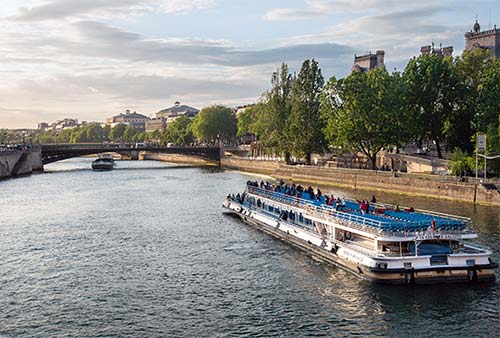
Bateaux-Mouches cruises depart from Pont de l’Alma’s right bank and have the biggest open-top, double-decker boats (higher up means better views). But this company caters to tour groups, making their boats jammed and noisy (€15, kids 4-12-€6, +33 1 42 25 96 10, www.bateaux-mouches.fr).
Bateaux Parisiens has smaller boats with audioguides, fewer crowds, and only one deck. Skip this cruise if the boat lacks an outdoor deck. It leaves from right in front of the Eiffel Tower (€17, kids 3-12-€7.50, +33 1 76 64 14 45, www.bateauxparisiens.com).
Vedettes de Paris boats also anchor below the Eiffel Tower. Most of their boats offer good outdoor seating plus a small bar onboard. Their round-trip allows a stopover to explore the Notre-Dame area and catch the next boat back (€20, +33 1 44 18 19 50, www.vedettesdeparis.fr).
Vedettes du Pont Neuf offers essentially the same one-hour tour as the other companies with smaller boats; it starts and ends at Pont Neuf, closer to recommended hotels in the Marais and Luxembourg Garden neighborhoods. The boats feature a live guide whose delivery (in English and French) may be as stiff as a recorded narration (€13, kids 4-12-€6, tip requested, nearly 2/hour, daily 10:30-22:30, other cruises available—check online, +33 1 46 33 98 38, www.vedettesdupontneuf.com).
Canauxrama runs a variety of relaxing cruises (with live commentary) on the Seine or along the tranquil Canal St. Martin (€20, check online for routes, +33 1 42 39 15 00, www.canauxrama.com).
Batobus allows you to get on and off as often as you like at any of eight popular stops along the Seine. Boats make a continuous circuit and stop in this order: Eiffel Tower, Invalides, Orsay Museum, St. Germain-des-Prés, Notre-Dame, Jardin des Plantes, Hôtel de Ville, the Louvre, and Pont Alexandre III, near the Champs-Elysées (1 day-€19, 2 days-€21, boats run every 15 minutes 10:00-21:30 in April-Aug, every 20 minutes and shorter hours in off-season, 45 minutes one-way, 1.5-hour round-trip, www.batobus.com). This is fun as a scenic, floating alternative to the Métro, but if you just want a guided boat tour, the Seine cruises described earlier are a better choice.
For food-oriented walking tours, see here.
Paris Walks offers a variety of thoughtful and entertaining two-hour walks, led by British and American guides (€15-25, generally 2/day—morning and afternoon, private tours available, family-friendly and Louvre tours are a specialty, check current offerings online, +33 1 48 09 21 40, www.paris-walks.com, paris@paris-walks.com). Tours focus on the Marais, Montmartre, St. Germain-des-Prés, and the medieval Latin Quarter, with themes spanning the Occupation and Resistance, the Revolution, and Hemingway’s Paris (all tours must be reserved in advance, best by email). No advance payment is required for general tours, but for specialty tours—such as the Louvre, the Orsay, fashion, or chocolate—you’ll prepay with a credit card when you reserve (deposits are nonrefundable).
Context Travel offers private and small group walking tours for travelers serious about learning. Led by historians, architects, and academics, tours range from traditional topics (French art history in the Louvre, Gothic architecture of Notre-Dame, etc.) to neighborhood explorations. They also run small group excursions to Normandy, Versailles, Giverny, and other regions in France. Book in advance—group sizes are limited (Paris walking tours from €130/person, does not include sight admissions, generally 3 hours but can last multiple days, US +1 800 691 6036, www.contexttravel.com, info@contexttravel.com).
Fat Tire Tours offers high-on-fun and casual walking tours, including neighborhood walks (Ile de la Cité, Montmartre, Père Lachaise Cemetery, etc.) and themed walks (French Revolution, Emily in Paris, and more). Their “Skip the Line” tours get you into major sights (such as Versailles) but are most worthwhile for the Eiffel Tower and Catacombs. Reservations are required and can be made online, by phone, or in person at their office near the Eiffel Tower (from €25/person for walking tours, from €52/person for “Skip the Line” tours; RS%—€2 off/person, 2-discount maximum; for contact details, see Fat Tire listing earlier, under “Getting Around Paris—By Bike”).
Paris Muse Tours offers guided scavenger hunt-like tours to explore historic areas and sights. Clever storytelling incorporates interaction that’s fun for all ages. Imagine yourself as a detective at the Louvre or a 19th-century art writer at the Orsay, or solve a real-life French Revolution murder mystery on the streets of Paris (€200-450 depending on group size, up to 8 people, 2.5 hours, +33 6 73 77 33 52, https://parismuse.com).
For many, Paris merits hiring a Parisian as a personal guide (€240-300 half-day, €400-500 full day). Thierry Gauduchon is a terrific guide and a gifted teacher (+33 6 19 07 30 77, tgauduchon@gmail.com). Elisabeth Van Hest is another likable and very capable guide (+33 1 43 41 47 31, mobile +33 6 77 80 19 89, elisa.guide@gmail.com). Vincent Cabaret is a fun guide for Paris’ city center, day trips (he’s particularly terrific for Versailles), and beyond (+33 6 82 19 67 23, vincentcabaret@ymail.com). Sylvie Moreau also leads good tours (+33 1 74 30 27 46 or +33 6 87 02 80 67, sylvie.ja.moreau@gmail.com). Arnaud Servignat is a top guide who has taught me much about Paris (also does minivan tours of the countryside around Paris, +33 6 68 80 29 05, www.french-guide.com, arnotour@icloud.com). Joelle Valette-Coat is an effective teacher who takes her art seriously (+33 1 46 06 74 95 or +33 6 86 28 32 20, jvalettecoat@hotmail.com).
A bike tour is a fun way to see Paris. Both Bike About Tours and Fat Tire Tours offer tours and bike maps of Paris and give good advice on cycling routes in the city. Their tour routes cover different areas of the city, so avid cyclists could do both without much repetition.
Bike About Tours offers easygoing 3.5-hour bike tours. The Hidden Paris tour includes a backstreet spin through the Marais, Latin Quarter, and Ile St. Louis. Their Monuments tour takes you past the Louvre, Eiffel Tower, and other classics (€45, RS%—10 percent discount, helmets on request, 12-person maximum group size—reserve online to guarantee a spot or show up and take your chances; for address and contact info see listing earlier, under “Getting Around Paris—By Bike”).
Over at Fat Tire Tours, a gang of Anglophone expats offers an extensive program of three-hour bike tours of Paris day and night (from €39/person, RS%—€4 off/person, 2-discount maximum; reservations recommended but not required; tours leave daily rain or shine). Kid-size bikes are available, as are tandem attachments and baby seats. You’ll pedal with a pack of up to 16 riders, mostly in parks and along bike lanes, with a lunch stop in the Tuileries Garden. Livelier night tours follow a route past floodlit monuments and include a boat cruise on the Seine. (For contact info, see listing earlier, under “Getting Around Paris—By Bike”.) They also run bike tours to Versailles and Giverny (see website for details).
Boutique Bike Tours is a small, well-run outfit leading good bike tours of Paris (day and night) and Versailles (+33 6 12 61 00 90, www.boutiquebiketours.com).
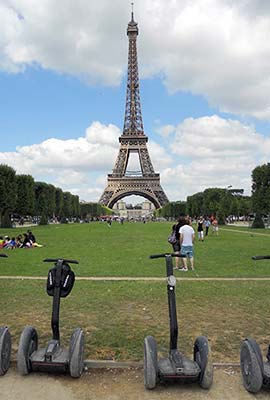
Fat Tire offers pricey two-hour City Segway Tours. Learn to ride these stand-up motorized scooters while exploring Paris (you’ll get the hang of it after about a half-hour). These tours take no more than eight people at a time, so reservations are required. Kids must be at least 12 years old and 100 pounds (€59, April-Oct generally 2/day; see Fat Tire Tours listing under “Getting Around Paris—By Bike,” earlier).
You’ll find these three-wheeled, pedal-powered vehicles at key sights in Paris. Cyclopolitain Paris can usually be found outside the Shakespeare and Company bookstore, on Place du Parvis de Notre-Dame. Grab one for anything from a short taxi trip to a night tour (allow €60/hour, 3-person maximum).
Avoid these elongated golf cart-like vehicle tours that overcharge and underdeliver (€90 for 45-minute tour).
You’ll never run out of things to do in Paris, but the outlying areas may lure you out of the city. The grand châteaux at Versailles, Vaux-le-Vicomte, and Fontainebleau, the cathedral at Chartres, Monet’s garden at Giverny, and the artist town of Auvers-sur-Oise are all within reach as day trips. Go on your own, with a bus or minivan tour, or with a local guide: Most of the guides listed earlier will do excursion tours from Paris using your rental car. For details on doing these trips on your own or by bus or minivan tour, see the individual destination chapters.
It’s easy to arrange day trips from Paris to places around northern France, such as Reims, the Loire Valley, and the D-Day beaches of Normandy (all beyond the scope of this book, but well covered in Rick Steves France). Thanks to bullet trains and good local guides who can help you maximize your time, well-coordinated blitz-tour trips to these places are doable (though hardly relaxing). To see these places in a day, I recommend using a guide from the region who will meet you at the train station (most have cars) and show you the highlights before getting you back on your return train to Paris. Book well in advance, especially for the D-Day beaches.
Reims: For a day trip to Reims, check out France Bubbles Tours (www.france-bubbles-tours.com). The wine gurus at Ô Château in Paris offer day trips and tastings to Reims and Champagne (see here for contact info).
Loire Valley: Pascal Accolay runs Acco-Dispo, which offers good all-day château tours from the city of Tours—an hour from Paris by train (+33 6 82 00 64 51, www.accodispo-tours.com).
D-Day Beaches: An army of small companies offers all-day excursions to the D-Day beaches from Bayeux or Caen, both reachable by train from Paris in 2.5 hours or less. These guides are top notch: Dale Booth Normandy Tours (Dale Booth, +33 2 14 16 66 14, www.dboothnormandytours.com, dboothholidays@aol.com), D-Day Experience Tours (Sylvain Kast, +33 6 17 44 04 46, www.d-day-experience-tours.com), Normandy American Heroes Tours (Rodolphe Passera, +33 6 30 55 63 39, www.normandyamericanheroes.com, rudy@normandyamericanheroes.com), and D-Day Guided Tours (Mathias Leclere, www.ddayguidedtours.com).
Gold Beach Company takes individual signups for their well-priced and well-run minivan tours of the D-Day beaches (+33 9 67 82 05 14, www.goldbeachcompany.com).
If you’d be happier letting someone else arrange the logistics, the following companies offer convenient transportation and a smidgen of guiding to destinations outside Paris.
Paris Webservices, a reliable outfit, offers private group day trips to Giverny, Auvers-sur-Oise, and Versailles with well-trained, English-speaking chauffeur/guides in cushy minivans (figure €95-140/person for groups of 4 or more, RS%—use code RICK-24-STEVES, +33 9 52 06 02 59, 18 Rue José Maria de Héredia, www.pariswebservices.com).
Paris City Vision runs bus tours to several popular regional destinations (3 Place des Pyramides, Mo: Pyramides, www.pariscityvision.com). Their full-size bus tours are multilingual, mass-marketed, and mediocre at best, but can be worthwhile simply for the ease of transportation to the sights (about €50-170, destinations include Versailles, Giverny, Mont St-Michel, D-Day beaches, and more).